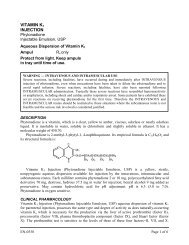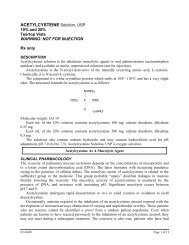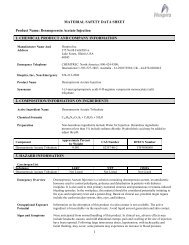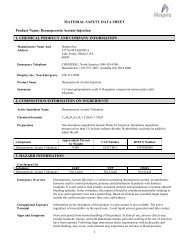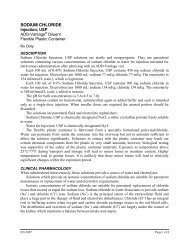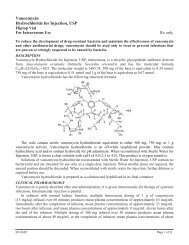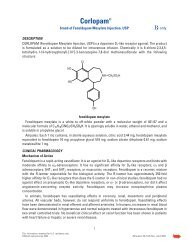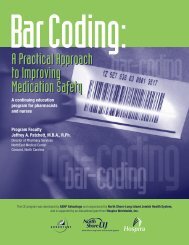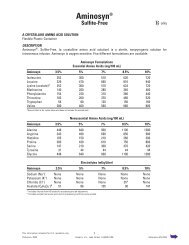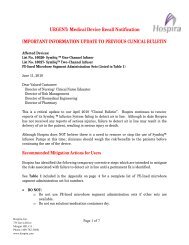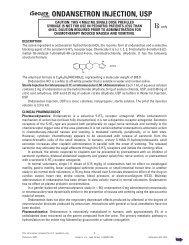Fludarabine Phosphate for Injection, USP - Hospira
Fludarabine Phosphate for Injection, USP - Hospira
Fludarabine Phosphate for Injection, USP - Hospira
You also want an ePaper? Increase the reach of your titles
YUMPU automatically turns print PDFs into web optimized ePapers that Google loves.
<strong>Fludarabine</strong> <strong>Phosphate</strong> <strong>for</strong> <strong>Injection</strong>, <strong>USP</strong><br />
For Intravenous Use Only only<br />
WARNING: <strong>Fludarabine</strong> <strong>Phosphate</strong> <strong>for</strong> <strong>Injection</strong>, <strong>USP</strong> should be administered under the supervision of a<br />
qualified physician experienced in the use of antineoplastic therapy. <strong>Fludarabine</strong> <strong>Phosphate</strong> <strong>for</strong> <strong>Injection</strong>, <strong>USP</strong><br />
can severely suppress bone marrow function. When used at high doses in dose-ranging studies in patients<br />
with acute leukemia, <strong>Fludarabine</strong> <strong>Phosphate</strong> <strong>for</strong> <strong>Injection</strong>, <strong>USP</strong> was associated with severe neurologic effects,<br />
including blindness, coma, and death. This severe central nervous system toxicity occurred in 36% of patients<br />
treated with doses approximately four times greater (96 mg/m 2 /day <strong>for</strong> 5 to 7 days) than the recommended<br />
dose. Similar severe central nervous system toxicity has been rarely (≤ 0.2%) reported in patients treated at<br />
doses in the range of the dose recommended <strong>for</strong> chronic lymphocytic leukemia.<br />
Instances of life-threatening and sometimes fatal autoimmune phenomena such as hemolytic anemia,<br />
autoimmune thrombocytopenia/thrombocytopenic purpura (ITP), Evan’s syndrome, and acquired hemophilia<br />
have been reported to occur after one or more cycles of treatment with <strong>Fludarabine</strong> <strong>Phosphate</strong> <strong>for</strong> <strong>Injection</strong>,<br />
<strong>USP</strong>. Patients undergoing treatment with <strong>Fludarabine</strong> <strong>Phosphate</strong> <strong>for</strong> <strong>Injection</strong>, <strong>USP</strong> should be evaluated and<br />
closely monitored <strong>for</strong> hemolysis.<br />
In a clinical investigation using <strong>Fludarabine</strong> <strong>Phosphate</strong> <strong>for</strong> <strong>Injection</strong>, <strong>USP</strong> in combination with pentostatin<br />
(deoxyco<strong>for</strong>mycin) <strong>for</strong> the treatment of refractory chronic lymphocytic leukemia (CLL), there was an<br />
unacceptably high incidence of fatal pulmonary toxicity. There<strong>for</strong>e, the use of <strong>Fludarabine</strong> <strong>Phosphate</strong> <strong>for</strong><br />
<strong>Injection</strong>, <strong>USP</strong> in combination with pentostatin is not recommended.<br />
DESCRIPTION<br />
<strong>Fludarabine</strong> <strong>Phosphate</strong> <strong>for</strong> <strong>Injection</strong>, <strong>USP</strong> contains fludarabine phosphate, <strong>USP</strong>, a fluorinated nucleotide analog of the<br />
antiviral agent vidarabine, 9-β-D-arabinofuranosyladenine (ara-A) that is relatively resistant to deamination by adenosine<br />
deaminase. Each vial of sterile lyophilized solid cake contains 50 mg of the active ingredient fludarabine phosphate,<br />
<strong>USP</strong>, 50 mg of mannitol, and sodium hydroxide to adjust pH to 7.7. The pH range <strong>for</strong> the final product is 7.2 to 8.2.<br />
Reconstitution with 2 mL of Sterile Water <strong>for</strong> <strong>Injection</strong>, <strong>USP</strong> results in a solution containing 25 mg/mL of fludarabine<br />
phosphate, <strong>USP</strong> intended <strong>for</strong> intravenous administration.<br />
The chemical name <strong>for</strong> fludarabine phosphate, <strong>USP</strong> is 9H-Purin-6-amine, 2-fluoro-9-(5-O-phosphono- β<br />
-D-arabinofuranosyl)(2-fluoro-ara-AMP). The molecular <strong>for</strong>mula of fludarabine phosphate, <strong>USP</strong> is C 10 H 13 FN 5 O 7 P<br />
(MW 365.2) and the structure is:<br />
CLINICAL PHARMACOLOGY<br />
<strong>Fludarabine</strong> phosphate, <strong>USP</strong> is rapidly dephosphorylated to 2-fluoro-ara-A and then phosphorylated intracellularly by<br />
deoxycytidine kinase to the active triphosphate, 2-fluoro-ara-ATP. This metabolite appears to act by inhibiting DNA<br />
polymerase alpha, ribonucleotide reductase and DNA primase, thus inhibiting DNA synthesis. The mechanism of action<br />
of this antimetabolite is not completely characterized and may be multi-faceted.<br />
Phase I studies in humans have demonstrated that fludarabine phosphate, <strong>USP</strong> is rapidly converted to the active<br />
metabolite, 2-fluoro-ara-A, within minutes after intravenous infusion. Consequently, clinical pharmacology studies<br />
This in<strong>for</strong>mation intended <strong>for</strong> U.S. residents only. 1<br />
©<strong>Hospira</strong>, 2008 <strong>Hospira</strong>, Inc., Lake Forest, IL 60045 USA Reference 482346-PROMOWEB
<strong>Fludarabine</strong> <strong>Phosphate</strong> <strong>for</strong> <strong>Injection</strong>, <strong>USP</strong><br />
have focused on 2-fluoro-ara-A pharmacokinetics. After the five daily doses of 25 mg 2-fluoro-ara-AMP/m 2 to cancer<br />
patients infused over 30 minutes, 2-fluoro-ara-A concentrations show a moderate accumulation. During a 5-day<br />
treatment schedule, 2-fluoro-ara-A plasma trough levels increased by a factor of about 2. The terminal half-life of<br />
2-fluoro-ara-A was estimated as approximately 20 hours. In vitro, plasma protein binding of fludarabine ranged between<br />
19% and 29%.<br />
A correlation was noted between the degree of absolute granulocyte count nadir and increased area under the<br />
concentration x time curve (AUC).<br />
Special Populations<br />
Pediatric Patients<br />
Limited pharmacokinetic data <strong>for</strong> fludarabine phosphate, <strong>USP</strong> are available from a published study of children<br />
(ages 1 to 21 years) with refractory acute leukemias or solid tumors (Children’s Cancer Group Study 097 1 ). When<br />
fludarabine phosphate, <strong>USP</strong> was administered as a loading dose over 10 minutes immediately followed by a 5-day<br />
continuous infusion, steady-state conditions were reached early.<br />
Patients with Renal Impairment<br />
The total body clearance of the principal metabolite 2-fluoro-ara-A correlated with the creatinine clearance, indicating<br />
the importance of the renal excretion pathway <strong>for</strong> the elimination of the drug. Renal clearance represents approximately<br />
40% of the total body clearance. Patients with moderate renal impairment (17 to 41 mL/min/m 2 ) receiving 20% reduced<br />
fludarabine phosphate, <strong>USP</strong> dose had a similar exposure (AUC; 21 versus 20 nM•h/mL) compared to patients with<br />
normal renal function receiving the recommended dose. The mean total body clearance was 172 mL/min <strong>for</strong> normal and<br />
124 mL/min <strong>for</strong> patients with moderately impaired renal function.<br />
Clinical Studies<br />
Two single-arm open-label studies of fludarabine phosphate, <strong>USP</strong> have been conducted in adult patients with CLL<br />
refractory to at least one prior standard alkylating-agent containing regimen. In a study conducted by M.D. Anderson<br />
Cancer Center (MDAH), 48 patients were treated with a dose of 22 to 40 mg/m 2 daily <strong>for</strong> 5 days every 28 days. Another<br />
study conducted by the Southwest Oncology Group (SWOG) involved 31 patients treated with a dose of 15 to 25 mg/m 2<br />
daily <strong>for</strong> 5 days every 28 days. The overall objective response rates were 48% and 32% in the MDAH and SWOG<br />
studies, respectively. The complete response rate in both studies was 13%; the partial response rate was 35% in the<br />
MDAH study and 19% in the SWOG study. These response rates were obtained using standardized response criteria<br />
developed by the National Cancer Institute CLL Working Group 3 and were achieved in heavily pre-treated patients. The<br />
ability of fludarabine phosphate, <strong>USP</strong> to induce a significant rate of response in refractory patients suggests minimal<br />
cross-resistance with commonly used anti-CLL agents.<br />
The median time to response in the MDAH and SWOG studies was 7 weeks (range of 1 to 68 weeks) and 21 weeks<br />
(range of 1 to 53 weeks) respectively. The median duration of disease control was 91 weeks (MDAH) and 65 weeks<br />
(SWOG). The median survival of all refractory CLL patients treated with fludarabine phosphate, <strong>USP</strong> was 43 weeks and<br />
52 weeks in the MDAH and SWOG studies, respectively.<br />
Rai stage improved to Stage II or better in 7 of 12 MDAH responders (58%) and in 5 of 7 SWOG responders (71%)<br />
who were Stage III or IV at baseline. In the combined studies, mean hemoglobin concentration improved from<br />
9.0 g/dL at baseline to 11.8 g/dL at the time of response in a subgroup of anemic patients. Similarly, average platelet<br />
count improved from 63,500/mm 3 to 103,300/mm 3 at the time of response in a subgroup of patients who were<br />
thrombocytopenic at baseline.<br />
INDICATIONS AND USAGE<br />
<strong>Fludarabine</strong> <strong>Phosphate</strong> <strong>for</strong> <strong>Injection</strong>, <strong>USP</strong> is indicated <strong>for</strong> the treatment of adult patients with B-cell chronic lymphocytic<br />
leukemia (CLL) who have not responded to or whose disease has progressed during treatment with at least one<br />
standard alkylating-agent containing regimen. The safety and effectiveness of fludarabine phosphate, <strong>USP</strong> in previously<br />
untreated or non-refractory patients with CLL have not been established.<br />
CONTRAINDICATIONS<br />
<strong>Fludarabine</strong> phosphate, <strong>USP</strong> is contraindicated in those patients who are hypersensitive to this drug or its components.<br />
This in<strong>for</strong>mation intended <strong>for</strong> U.S. residents only. 2<br />
©<strong>Hospira</strong>, 2008 <strong>Hospira</strong>, Inc., Lake Forest, IL 60045 USA Reference 482346-PROMOWEB
<strong>Fludarabine</strong> <strong>Phosphate</strong> <strong>for</strong> <strong>Injection</strong>, <strong>USP</strong><br />
WARNINGS<br />
(See BOXED WARNINGS)<br />
There are clear dose-dependent toxic effects seen with fludarabine phosphate, <strong>USP</strong>. Dose levels approximately 4 times<br />
greater (96 mg/m2 /day <strong>for</strong> 5 to 7 days) than that recommended <strong>for</strong> CLL (25 mg/m2 /day <strong>for</strong> 5 days) were associated with<br />
a syndrome characterized by delayed blindness, coma and death. Symptoms appeared from 21 to 60 days following<br />
the last dose. Thirteen of 36 patients (36%) who received fludarabine phosphate, <strong>USP</strong> at high doses (96 mg/m2 /day<br />
<strong>for</strong> 5 to 7 days) developed this severe neurotoxicity. This syndrome has been reported rarely in patients treated with<br />
doses in the range of the recommended CLL dose of 25 mg/m2 /day <strong>for</strong> 5 days every 28 days. The effect of chronic<br />
administration of fludarabine phosphate, <strong>USP</strong> on the central nervous system is unknown; however, patients have<br />
received the recommended dose <strong>for</strong> up to 15 courses of therapy.<br />
Severe bone marrow suppression, notably anemia, thrombocytopenia and neutropenia, has been reported in patients<br />
treated with fludarabine phosphate, <strong>USP</strong>. In a Phase I study in adult solid tumor patients, the median time to nadir<br />
counts was 13 days (range, 3 to 25 days) <strong>for</strong> granulocytes and 16 days (range, 2 to 32) <strong>for</strong> platelets. Most patients<br />
had hematologic impairment at baseline either as a result of disease or as a result of prior myelosuppressive therapy.<br />
Cumulative myelosuppression may be seen. While chemotherapy-induced myelosuppression is often reversible,<br />
administration of fludarabine phosphate, <strong>USP</strong> requires careful hematologic monitoring.<br />
Several instances of trilineage bone marrow hypoplasia or aplasia resulting in pancytopenia, sometimes resulting in<br />
death, have been reported in adult patients. The duration of clinically significant cytopenia in the reported cases has<br />
ranged from approximately 2 months to approximately 1 year. These episodes have occurred both in previously treated<br />
or untreated patients.<br />
Instances of life-threatening and sometimes fatal autoimmune phenomena such as hemolytic anemia, autoimmune<br />
thrombocytopenia/thrombocytopenic purpura (ITP), Evan’s syndrome, and acquired hemophilia have been reported<br />
to occur after one or more cycles of treatment with fludarabine phosphate, <strong>USP</strong> in patients with or without a previous<br />
history of autoimmune hemolytic anemia or a positive Coombs’ test and who may or may not be in remission from<br />
their disease. Steroids may or may not be effective in controlling these hemolytic episodes. The majority of patients<br />
rechallenged with fludarabine phosphate, <strong>USP</strong> developed a recurrence in the hemolytic process. The mechanism(s)<br />
which predispose patients to the development of this complication has not been identified. Patients undergoing<br />
treatment with fludarabine phosphate, <strong>USP</strong> should be evaluated and closely monitored <strong>for</strong> hemolysis. Discontinuation of<br />
therapy with fludarabine phosphate, <strong>USP</strong> is recommended in case of hemolysis.<br />
Transfusion-associated graft-versus-host disease has been observed after transfusion of non-irradiated blood in<br />
fludarabine phosphate, <strong>USP</strong> treated patients. Fatal outcome as a consequence of this disease has been reported.<br />
There<strong>for</strong>e, to minimize the risk of transfusion-associated graft-versus-host disease, patients who require blood<br />
transfusion and who are undergoing, or who have received, treatment with fludarabine phosphate, <strong>USP</strong> should receive<br />
irradiated blood only.<br />
In a clinical investigation using fludarabine phosphate, <strong>USP</strong> in combination with pentostatin (deoxyco<strong>for</strong>mycin) <strong>for</strong><br />
the treatment of refractory chronic lymphocytic leukemia (CLL) in adults, there was an unacceptably high incidence<br />
of fatal pulmonary toxicity. There<strong>for</strong>e, the use of fludarabine phosphate, <strong>USP</strong> in combination with pentostatin is not<br />
recommended.<br />
Of the 133 adult CLL patients in the two trials, there were 29 fatalities during study. Approximately 50% of the fatalities<br />
were due to infection and 25% due to progressive disease.<br />
Pregnancy Category D: <strong>Fludarabine</strong> phosphate, <strong>USP</strong> may cause fetal harm when administered to a pregnant woman.<br />
<strong>Fludarabine</strong> phosphate, <strong>USP</strong> was teratogenic in rats and in rabbits. <strong>Fludarabine</strong> phosphate, <strong>USP</strong> was administered<br />
intravenously at doses of 0, 1, 10 or 30 mg/kg/day to pregnant rats on days 6 to 15 of gestation. At 10 and<br />
30 mg/kg/day in rats, there was an increased incidence of various skeletal mal<strong>for</strong>mations. <strong>Fludarabine</strong> phosphate, <strong>USP</strong><br />
was administered intravenously at doses of 0, 1, 5 or 8 mg/kg/day to pregnant rabbits on days 6 to 15 of gestation.<br />
Dose-related teratogenic effects manifested by external de<strong>for</strong>mities and skeletal mal<strong>for</strong>mations were observed in the<br />
rabbits at 5 and 8 mg/kg/day. Drug-related deaths or toxic effects on maternal and fetal weights were not observed.<br />
There are no adequate and well-controlled studies in pregnant women.<br />
If fludarabine phosphate, <strong>USP</strong> is used during pregnancy, or if the patient becomes pregnant while taking this drug, the<br />
patient should be apprised of the potential hazard to the fetus. Women of childbearing potential or fertile males must<br />
take contraceptive measures during and at least <strong>for</strong> 6 months after cessation of therapy.<br />
This in<strong>for</strong>mation intended <strong>for</strong> U.S. residents only. 3<br />
©<strong>Hospira</strong>, 2008 <strong>Hospira</strong>, Inc., Lake Forest, IL 60045 USA Reference 482346-PROMOWEB
<strong>Fludarabine</strong> <strong>Phosphate</strong> <strong>for</strong> <strong>Injection</strong>, <strong>USP</strong><br />
PRECAUTIONS<br />
General<br />
<strong>Fludarabine</strong> phosphate, <strong>USP</strong> is a potent antineoplastic agent with potentially significant toxic side effects. Patients<br />
undergoing therapy should be closely observed <strong>for</strong> signs of hematologic and nonhematologic toxicity. Periodic<br />
assessment of peripheral blood counts is recommended to detect the development of anemia, neutropenia and<br />
thrombocytopenia.<br />
Tumor lysis syndrome associated with fludarabine phosphate, <strong>USP</strong> treatment has been reported in CLL patients with<br />
large tumor burdens. Since fludarabine phosphate, <strong>USP</strong> can induce a response as early as the first week of treatment,<br />
precautions should be taken in those patients at risk of developing this complication.<br />
In patients with impaired state of health, fludarabine phosphate, <strong>USP</strong> should be given with caution and after careful<br />
risk/benefit consideration. This applies especially <strong>for</strong> patients with severe impairment of bone marrow function<br />
(thrombocytopenia, anemia, and/or granulocytopenia), immunodeficiency or with a history of opportunistic infection.<br />
Prophylactic treatment should be considered in patients at increased risk of developing opportunistic infections.<br />
There are inadequate data on dosing of patients with renal insufficiency. <strong>Fludarabine</strong> phosphate, <strong>USP</strong> must be<br />
administered cautiously in patients with renal insufficiency. The total body clearance of 2-fluoro-ara-A has been shown<br />
to be directly correlated with creatinine clearance. Patients with moderate impairment of renal function (creatinine<br />
clearance 30 to 70 mL/min/1.73 m2 ) should have their fludarabine dose reduced by 20% and be monitored closely.<br />
<strong>Fludarabine</strong> is not recommended <strong>for</strong> patients with severely impaired renal function (creatinine clearance less than<br />
30 mL/min/1.73 m2 ).<br />
<strong>Fludarabine</strong> phosphate, <strong>USP</strong> may reduce the ability to drive or use machines, since fatigue, weakness and visual<br />
disturbances have been observed.<br />
Laboratory Tests<br />
During treatment, the patient’s hematologic profile (particularly neutrophils and platelets) should be monitored regularly<br />
to determine the degree of hematopoietic suppression.<br />
Drug Interactions<br />
The use of fludarabine phosphate, <strong>USP</strong> in combination with pentostatin is not recommended due to the risk of severe<br />
pulmonary toxicity (see WARNINGS section).<br />
Carcinogenesis<br />
No animal carcinogenicity studies with fludarabine phosphate, <strong>USP</strong> have been conducted.<br />
Mutagenesis<br />
<strong>Fludarabine</strong> phosphate, <strong>USP</strong> was not mutagenic to bacteria (Ames test) or mammalian cells (HGRPT assay in Chinese<br />
hamster ovary cells) either in the presence or absence of metabolic activation. <strong>Fludarabine</strong> phosphate, <strong>USP</strong> was<br />
clastogenic in vitro to Chinese hamster ovary cells (chromosome aberrations in the presence of metabolic activation)<br />
and induced sister chromatid exchanges both with and without metabolic activation. In addition, fludarabine phosphate,<br />
<strong>USP</strong> was clastogenic in vivo (mouse micronucleus assay) but was not mutagenic to germ cells (dominant lethal test in<br />
male mice).<br />
Impairment of Fertility<br />
Studies in mice, rats and dogs have demonstrated dose-related adverse effects on the male reproductive system.<br />
Observations consisted of a decrease in mean testicular weights in mice and rats with a trend toward decreased<br />
testicular weights in dogs and degeneration and necrosis of spermatogenic epithelium of the testes in mice, rats and<br />
dogs. The possible adverse effects on fertility in humans have not been adequately evaluated.<br />
Pregnancy<br />
Pregnancy Category D: (See WARNINGS section).<br />
Nursing Mothers<br />
It is not known whether this drug is excreted in human milk. Because many drugs are excreted in human milk and<br />
because of the potential <strong>for</strong> serious adverse reactions in nursing infants from fludarabine phosphate, <strong>USP</strong>, a decision<br />
should be made to discontinue nursing or discontinue the drug, taking into account the importance of the drug <strong>for</strong><br />
the mother.<br />
This in<strong>for</strong>mation intended <strong>for</strong> U.S. residents only. 4<br />
©<strong>Hospira</strong>, 2008 <strong>Hospira</strong>, Inc., Lake Forest, IL 60045 USA Reference 482346-PROMOWEB
<strong>Fludarabine</strong> <strong>Phosphate</strong> <strong>for</strong> <strong>Injection</strong>, <strong>USP</strong><br />
Pediatric Use<br />
Data submitted to the FDA was insufficient to establish efficacy in any childhood malignancy. <strong>Fludarabine</strong> was evaluated<br />
in 62 pediatric patients (median age 10, range 1 to 21) with refractory acute leukemia (45 patients) or solid tumors<br />
(17 patients). The fludarabine regimen tested <strong>for</strong> pediatric acute lymphocytic leukemia (ALL) patients was a loading<br />
bolus of 10.5 mg/m 2 /day followed by a continuous infusion of 30.5 mg/m 2 /day <strong>for</strong> 5 days. In 12 pediatric patients<br />
with solid tumors, dose-limiting myelosuppression was observed with a loading dose of 8 mg/m 2 /day followed by a<br />
continuous infusion of 23.5 mg/m 2 /day <strong>for</strong> 5 days. The maximum tolerated dose was a loading dose of 7 mg/m 2 /day<br />
followed by a continuous infusion of 20 mg/m 2 /day <strong>for</strong> 5 days. Treatment toxicity included bone marrow suppression.<br />
Platelet counts appeared to be more sensitive to the effects of fludarabine than hemoglobin and white blood cell counts.<br />
Other adverse events included fever, chills, asthenia, rash, nausea, vomiting, diarrhea, and infection. There were no<br />
reported occurrences of peripheral neuropathy or pulmonary hypersensitivity reaction.<br />
Vaccination<br />
During and after treatment with fludarabine phosphate, <strong>USP</strong>, vaccination with live vaccines should be avoided.<br />
Disease Progression<br />
Disease progression and trans<strong>for</strong>mation (e.g. Richter’s syndrome) have been reported in CLL patients.<br />
ADVERSE REACTIONS<br />
The most common adverse events include myelosuppression (neutropenia, thrombocytopenia and anemia), fever and<br />
chills, infection, and nausea and vomiting. Other commonly reported events include malaise, fatigue, anorexia, and<br />
weakness. Serious opportunistic infections have occurred in CLL patients treated with fludarabine phosphate, <strong>USP</strong>.<br />
Adverse events, and those reactions which are more clearly related to the drug are arranged below according to body<br />
system.<br />
Hematopoietic Systems: Hematologic events (neutropenia, thrombocytopenia, and/or anemia) were reported in the<br />
majority of CLL patients treated with fludarabine phosphate, <strong>USP</strong>. During fludarabine phosphate, <strong>USP</strong> treatment of<br />
133 patients with CLL, the absolute neutrophil count decreased to less than 500/mm 3 in 59% of patients, hemoglobin<br />
decreased from pretreatment values by at least 2 grams percent in 60%, and platelet count decreased from<br />
pretreatment values by at least 50% in 55%. Myelosuppression may be severe, cumulative, and may affect multiple cell<br />
lines. Bone marrow fibrosis occurred in one CLL patient treated with fludarabine phosphate, <strong>USP</strong>.<br />
Several instances of trilineage bone marrow hypoplasia or aplasia resulting in pancytopenia, sometimes resulting in<br />
death, have been reported in postmarketing surveillance. The duration of clinically significant cytopenia in the reported<br />
cases has ranged from approximately 2 months to approximately 1 year. These episodes have occurred both in<br />
previously treated or untreated patients.<br />
Life-threatening and sometimes fatal autoimmune phenomena such as hemolytic anemia, autoimmune<br />
thrombocytopenia/thrombocytopenic purpura (ITP), Evan’s syndrome, and acquired hemophilia have been reported to<br />
occur in patients receiving fludarabine phosphate, <strong>USP</strong> (see WARNINGS section). The majority of patients rechallenged<br />
with fludarabine phosphate, <strong>USP</strong> developed a recurrence in the hemolytic process.<br />
In post-marketing experience, rare cases of myelodysplastic syndrome and acute myeloid leukemia associated with<br />
prior, concomitant or subsequent treatment with alkylating agents or irradiation have been reported.<br />
Infections: Serious, and sometimes fatal infections, including opportunistic infections and reactivations of latent viral<br />
infections such as VZV (Herpes zoster), Epstein-Barr virus and JC virus (progressive multifocal leukoencephalopathy)<br />
have been reported in patients treated with fludarabine phosphate, <strong>USP</strong>.<br />
Rare cases of Epstein Barr Virus (EBV) associated lymphoproliferative disorders have been reported in patients treated<br />
with fludarabine phosphate, <strong>USP</strong>.<br />
Metabolic: Tumor lysis syndrome has been reported in CLL patients treated with fludarabine phosphate, <strong>USP</strong>. This<br />
complication may include hyperuricemia, hyperphosphatemia, hypocalcemia, metabolic acidosis, hyperkalemia,<br />
hematuria, urate crystalluria, and renal failure. The onset of this syndrome may be heralded by flank pain and hematuria.<br />
Nervous System: (See WARNINGS section) Objective weakness, agitation, confusion, visual disturbances, optic<br />
neuritis, optic neuropathy, blindness and coma have occurred in CLL patients treated with fludarabine phosphate, <strong>USP</strong><br />
at the recommended dose. Peripheral neuropathy has been observed in patients treated with fludarabine phosphate,<br />
<strong>USP</strong> and one case of wrist-drop was reported.<br />
This in<strong>for</strong>mation intended <strong>for</strong> U.S. residents only. 5<br />
©<strong>Hospira</strong>, 2008 <strong>Hospira</strong>, Inc., Lake Forest, IL 60045 USA Reference 482346-PROMOWEB
<strong>Fludarabine</strong> <strong>Phosphate</strong> <strong>for</strong> <strong>Injection</strong>, <strong>USP</strong><br />
In post-marketing experience, cases of progressive multifocal leukoencephalopathy have been reported. Most cases had<br />
a fatal outcome. Many of these cases were confounded by prior and/or concurrent chemotherapy. The time to onset has<br />
ranged from a few weeks to approximately one year after initiating treatment.<br />
Pulmonary System: Pneumonia, a frequent manifestation of infection in CLL patients, occurred in 16%, and<br />
22% of those treated with fludarabine phosphate, <strong>USP</strong> in the MDAH and SWOG studies, respectively. Pulmonary<br />
hypersensitivity reactions to fludarabine phosphate, <strong>USP</strong> characterized by dyspnea, cough and interstitial pulmonary<br />
infiltrate have been observed.<br />
In post-marketing experience, cases of severe pulmonary toxicity have been observed with fludarabine use which<br />
resulted in ARDS, respiratory distress, pulmonary hemorrhage, pulmonary fibrosis, and respiratory failure. After an<br />
infectious origin has been excluded, some patients experienced symptom improvement with corticosteroids.<br />
Gastrointestinal System: Gastrointestinal disturbances such as nausea and vomiting, anorexia, diarrhea, stomatitis,<br />
and gastrointestinal bleeding have been reported in patients treated with fludarabine phosphate, <strong>USP</strong>.<br />
Cardiovascular: Edema has been frequently reported. One patient developed a pericardial effusion possibly related to<br />
treatment with fludarabine phosphate, <strong>USP</strong>. No other severe cardiovascular events were considered to be drug related.<br />
Genitourinary System: Rare cases of hemorrhagic cystitis have been reported in patients treated with fludarabine<br />
phosphate, <strong>USP</strong>.<br />
Skin: Skin toxicity, consisting primarily of skin rashes, has been reported in patients treated with fludarabine phosphate,<br />
<strong>USP</strong>.<br />
Erythema multi<strong>for</strong>me, Stevens-Johnson syndrome, toxic epidermal necrolysis, and pemphigus have been reported, with<br />
fatal outcomes in some cases.<br />
Worsening or flare up of pre-existing skin cancer lesions, as well as new onset of skin cancer, has been reported in<br />
patients during or after treatment with fludarabine phosphate, <strong>USP</strong>.<br />
Data in the following table are derived from the 133 patients with CLL who received fludarabine phosphate, <strong>USP</strong> in the<br />
MDAH and SWOG studies.<br />
PERCENT OF CLL PATIENTS REPORTING<br />
NON-HEMATOLOGIC ADVERSE EVENTS<br />
ADVERSE EVENTS MDAH (N=101) SWOG (N=32)<br />
ANY ADVERSE EVENT 88% 91%<br />
BODY AS A WHOLE 72 84<br />
FEVER 60 69<br />
CHILLS 11 19<br />
FATIGUE 10 38<br />
INFECTION 33 44<br />
PAIN 20 22<br />
MALAISE 8 6<br />
DIAPHORESIS 1 13<br />
ALOPECIA 0 3<br />
ANAPHYLAXIS 1 0<br />
HEMORRHAGE 1 0<br />
HYPERGLYCEMIA 1 6<br />
DEHYDRATION 1 0<br />
NEUROLOGICAL 21 69<br />
WEAKNESS 9 65<br />
PARESTHESIA 4 12<br />
HEADACHE 3 0<br />
VISUAL DISTURBANCE 3 15<br />
HEARING LOSS 2 6<br />
SLEEP DISORDER 1 3<br />
DEPRESSION 1 0<br />
CEREBELLAR SYNDROME 1 0<br />
IMPAIRED MENTATION 1 0<br />
This in<strong>for</strong>mation intended <strong>for</strong> U.S. residents only. 6<br />
©<strong>Hospira</strong>, 2008 <strong>Hospira</strong>, Inc., Lake Forest, IL 60045 USA Reference 482346-PROMOWEB
<strong>Fludarabine</strong> <strong>Phosphate</strong> <strong>for</strong> <strong>Injection</strong>, <strong>USP</strong><br />
PULMONARY 35 69<br />
COUGH 10 44<br />
PNEUMONIA 16 22<br />
DYSPNEA 9 22<br />
SINUSITIS 5 0<br />
PHARYNGITIS 0 9<br />
UPPER RESPIRATORY INFECTION 2 16<br />
ALLERGIC PNEUMONITIS 0 6<br />
EPISTAXIS 1 0<br />
HEMOPTYSIS 1 6<br />
BRONCHITIS 1 0<br />
HYPOXIA 1 0<br />
GASTROINTESTINAL 46 63<br />
NAUSEA/VOMITING 36 31<br />
DIARRHEA 15 13<br />
ANOREXIA 7 34<br />
STOMATITIS 9 0<br />
GI BLEEDING 3 13<br />
ESOPHAGITIS 3 0<br />
MUCOSITIS 2 0<br />
LIVER FAILURE 1 0<br />
ABNORMAL LIVER FUNCTION TEST 1 3<br />
CHOLELITHIASIS 0 3<br />
CONSTIPATION 1 3<br />
DYSPHAGIA 1 0<br />
CUTANEOUS 17 18<br />
RASH 15 15<br />
PRURITUS 1 3<br />
SEBORRHEA 1 0<br />
GENITOURINARY 12 22<br />
DYSURIA 4 3<br />
URINARY INFECTION 2 15<br />
HEMATURIA 2 3<br />
RENAL FAILURE 1 0<br />
ABNORMAL RENAL FUNCTION TEST 1 0<br />
PROTEINURIA 1 0<br />
HESITANCY 0 3<br />
CARDIOVASCULAR 12 38<br />
EDEMA 8 19<br />
ANGINA 0 6<br />
CONGESTIVE HEART FAILURE 0 3<br />
ARRHYTHMIA 0 3<br />
SUPRAVENTRICULAR TACHYCARDIA 0 3<br />
MYOCARDIAL INFARCTION 0 3<br />
DEEP VENOUS THROMBOSIS 1 3<br />
PHLEBITIS 1 3<br />
TRANSIENT ISCHEMIC ATTACK 1 0<br />
ANEURYSM 1 0<br />
CEREBROVASCULAR ACCIDENT 0 3<br />
MUSCULOSKELETAL 7 16<br />
MYALGIA 4 16<br />
OSTEOPOROSIS 2 0<br />
ARTHRALGIA 1 0<br />
TUMOR LYSIS SYNDROME 1 0<br />
More than 3000 adult patients received fludarabine phosphate, <strong>USP</strong> in studies of other leukemias, lymphomas, and<br />
other solid tumors. The spectrum of adverse effects reported in these studies was consistent with the data presented<br />
above.<br />
This in<strong>for</strong>mation intended <strong>for</strong> U.S. residents only. 7<br />
©<strong>Hospira</strong>, 2008 <strong>Hospira</strong>, Inc., Lake Forest, IL 60045 USA Reference 482346-PROMOWEB
<strong>Fludarabine</strong> <strong>Phosphate</strong> <strong>for</strong> <strong>Injection</strong>, <strong>USP</strong><br />
OVERDOSAGE<br />
High doses of fludarabine phosphate, <strong>USP</strong> (see WARNINGS section) have been associated with an irreversible central<br />
nervous system toxicity characterized by delayed blindness, coma, and death. High doses are also associated with<br />
severe thrombocytopenia and neutropenia due to bone marrow suppression. There is no known specific antidote <strong>for</strong><br />
fludarabine phosphate, <strong>USP</strong> overdosage. Treatment consists of drug discontinuation and supportive therapy.<br />
DOSAGE AND ADMINISTRATION<br />
Usual Dose:<br />
The recommended adult dose of <strong>Fludarabine</strong> <strong>Phosphate</strong> <strong>for</strong> <strong>Injection</strong>, <strong>USP</strong> is 25 mg/m 2 administered intravenously over<br />
a period of approximately 30 minutes daily <strong>for</strong> five consecutive days. Each 5 day course of treatment should commence<br />
every 28 days. Dosage may be decreased or delayed based on evidence of hematologic or nonhematologic toxicity.<br />
Physicians should consider delaying or discontinuing the drug if neurotoxicity occurs.<br />
A number of clinical settings may predispose to increased toxicity from fludarabine phosphate, <strong>USP</strong>. These include<br />
advanced age, renal insufficiency, and bone marrow impairment. Such patients should be monitored closely <strong>for</strong><br />
excessive toxicity and the dose modified accordingly.<br />
The optimal duration of treatment has not been clearly established. It is recommended that three additional cycles<br />
of fludarabine phosphate, <strong>USP</strong> be administered following the achievement of a maximal response and then the drug<br />
should be discontinued.<br />
Renal Insufficiency<br />
Adult patients with moderate impairment of renal function (creatinine clearance 30 to 70 mL/min/1.73 m 2 ) should<br />
have a 20% dose reduction of fludarabine phosphate, <strong>USP</strong>. <strong>Fludarabine</strong> phosphate, <strong>USP</strong> should not be administered to<br />
patients with severely impaired renal function (creatinine clearance less than 30 mL/min/1.73 m 2 ).<br />
Preparation of Solutions:<br />
<strong>Fludarabine</strong> <strong>Phosphate</strong> <strong>for</strong> <strong>Injection</strong>, <strong>USP</strong> should be prepared <strong>for</strong> parenteral use by aseptically adding Sterile Water <strong>for</strong><br />
<strong>Injection</strong>, <strong>USP</strong>. When reconstituted with 2 mL of Sterile Water <strong>for</strong> <strong>Injection</strong>, <strong>USP</strong>, the solid cake should fully dissolve<br />
in 15 seconds or less; each mL of the resulting solution will contain 25 mg of fludarabine phosphate, <strong>USP</strong>, 25 mg of<br />
mannitol, and sodium hydroxide to adjust the pH to 7.7. The pH range <strong>for</strong> the final product is 7.2 to 8.2. In clinical<br />
studies, the product has been diluted in 100 cc or 125 cc of 5% Dextrose <strong>Injection</strong>, <strong>USP</strong> or 0.9% Sodium Chloride,<br />
<strong>USP</strong>.<br />
Reconstituted <strong>Fludarabine</strong> <strong>Phosphate</strong> <strong>for</strong> <strong>Injection</strong>, <strong>USP</strong> contains no antimicrobial preservative and thus should be<br />
used within 8 hours of reconstitution. Care must be taken to assure the sterility of prepared solutions. Parenteral drug<br />
products should be inspected visually <strong>for</strong> particulate matter and discoloration prior to administration.<br />
<strong>Fludarabine</strong> <strong>Phosphate</strong> <strong>for</strong> <strong>Injection</strong>, <strong>USP</strong> should not be mixed with other drugs.<br />
Handling and Disposal:<br />
Procedures <strong>for</strong> proper handling and disposal should be considered. Consideration should be given to handling and<br />
disposal according to guidelines issued <strong>for</strong> cytotoxic drugs. Several guidelines on this subject have been published. 1-4<br />
There is no general agreement that all of the procedures recommended in the guidelines are necessary or appropriate.<br />
Caution should be exercised in the handling and preparation of <strong>Fludarabine</strong> <strong>Phosphate</strong> <strong>for</strong> <strong>Injection</strong>, <strong>USP</strong> solution.<br />
The use of latex gloves and safety glasses is recommended to avoid exposure in case of breakage of the vial or other<br />
accidental spillage. If the solution contacts the skin or mucous membranes, wash thoroughly with soap and water; rinse<br />
eyes thoroughly with plain water. Avoid exposure by inhalation or by direct contact of the skin or mucous membranes.<br />
<strong>Fludarabine</strong> <strong>Phosphate</strong> <strong>for</strong> <strong>Injection</strong>, <strong>USP</strong> should not be handled by pregnant staff.<br />
HOW SUPPLIED<br />
<strong>Fludarabine</strong> <strong>Phosphate</strong> <strong>for</strong> <strong>Injection</strong>, <strong>USP</strong> is supplied as a white, lyophilized solid cake. Each vial contains 50 mg of<br />
fludarabine phosphate, <strong>USP</strong>, 50 mg of mannitol, and sodium hydroxide to adjust pH to 7.7. The pH range <strong>for</strong> the final<br />
product is 7.2 to 8.2. Store at 20 to 25°C (68 to 77°F). [See <strong>USP</strong> Controlled Room Temperature.] Store upright.<br />
<strong>Fludarabine</strong> <strong>Phosphate</strong> <strong>for</strong> <strong>Injection</strong>, <strong>USP</strong> is supplied in a clear glass single dose vial and cartoned individually.<br />
NDC 61703-344-18<br />
This in<strong>for</strong>mation intended <strong>for</strong> U.S. residents only. 8<br />
©<strong>Hospira</strong>, 2008 <strong>Hospira</strong>, Inc., Lake Forest, IL 60045 USA Reference 482346-PROMOWEB
<strong>Fludarabine</strong> <strong>Phosphate</strong> <strong>for</strong> <strong>Injection</strong>, <strong>USP</strong><br />
REFERENCES<br />
1. Preventing Occupational Exposures to Antineoplastic and Other Hazardous Drugs in Health Care Settings. NIOSH<br />
Alert 2004-165.<br />
2. OSHA Technical Manual, TED 1-0.15A, Section VI: Chapter 2. Controlling Occupational Exposure to Hazardous Drugs.<br />
OSHA, 1999.<br />
http://www.osha.gov/dts/osta/otm/otm_vi_2.html<br />
3. American Society of Health-System Pharmacists. ASHP guidelines on handling hazardous drugs. Am J Health-Syst<br />
Pharm. 2006: 63: 1172-1193.<br />
4. Polovich, M., White, J.M., & Kelleher, L.O. (eds.) 2005. Chemotherapy and biotherapy guidelines and<br />
recommendations <strong>for</strong> practice (2nd ed.).Pittsburgh,PA: Oncology Nursing Society.<br />
<strong>Hospira</strong>, Inc.<br />
Lake Forest, IL 60045<br />
Product of Australia<br />
Rev. May 2008<br />
This in<strong>for</strong>mation intended <strong>for</strong> U.S. residents only. 9<br />
©<strong>Hospira</strong>, 2008 <strong>Hospira</strong>, Inc., Lake Forest, IL 60045 USA Reference 482346-PROMOWEB




